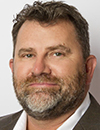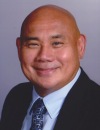07:30 | Conference Registration, Materials Pick-Up, Morning Coffee and Pastries |
|
Welcome and Introduction to the Conference by Conference Chairpersons |
| |
|
Venue: Coronado Ballroom C |
| |
09:00 |  | Conference Chair Welcome and Introduction to the Conference
Jana Stoudemire, Director, In-Space Manufacturing, Axiom Space, United States of America
|
|
09:00 |  | Conference Chair Welcome and Introduction to the Conference
Marc Giulianotti, Program Director, International Space Station U.S. National Laboratory, United States of America
|
|
09:15 |  | Keynote Presentation Tissue Engineering and Regenerative Medicine in Space: How the ISS National Lab is Your Gateway to Translational Innovation
Michael Roberts, Chief Scientific Officer, International Space Station National Laboratory, United States of America
The International Space Station is one of humankind’s greatest technical achievements—orbiting some 400 km above our planet and traveling at over 28,000 kilometers per hour. But even more importantly, the ISS has continuously enabled a human presence in space where astronauts have lived, worked, and conducted cutting edge R&D for 19 years. Aside from housing astronauts and hosting research facilities that push the boundaries of technology and innovation, the space station and the ISS National Lab have also been home to over 2,500 science experiments that leverage the unique space environment to benefit life on Earth and explorers traveling off of Earth. The ISS National Lab is available to a myriad of government, academic, and commercial researchers interested in looking at their science questions through a new lens. Among the new research programs in microgravity are multiple investigations in stem cells, organoids, organs on chips, regenerative medicine, tissue engineering, and 3D bioprinting that are already accelerating the pace of discovery to push us beyond the limits of our imagination to address health problems here on Earth. |
|
09:45 | Modeling the Effects of Spaceflight on the Human Heart Using Stem Cell-derived Cardiomyocytes
Arun Sharma, Assistant Professor, Cedars-Sinai Medical Center, United States of America
With extended stays aboard the International Space Station (ISS) becoming commonplace as humanity prepares for exploration-class space missions, the need to better understand the effects of microgravity on cardiac function during spaceflight is critical. However, primary human heart tissues, which would be useful for in vitro studies on heart function, are difficult to obtain and maintain. As a model system, we utilized cardiomyocytes (CMs) derived from human induced pluripotent stem cells (hiPSCs) to study the effects of microgravity on human cardiac function and gene expression at the cellular level. We derived hiPSCs from three healthy volunteers and produced hiPSC-CMs using a high-efficiency differentiation protocol. We cultured hiPSC-CMs in a microgravity environment aboard the ISS for approximately one month, during which weekly media changes were conducted. We analyzed the gene expression, structure, and function of space-flown and groundside control hiPSC-CM samples using RNA-sequencing, immunofluorescence, calcium imaging, and contractility assessment. This study represents the first time that hiPSC technology has been used to study the effects of spaceflight on human cardiomyocyte function and demonstrates that microgravity affects human cardiomyocyte function on the cellular level. |
10:15 | Morning Coffee Break and Networking in the Exhibit Hall |
10:45 | Stem Cell Regeneration in Space: Using Microgravity to Understand Earth-based Diseases
Elizabeth Blaber, Assistant Professor, Rensselaer Polytechnic Institute (RPI); Research Scientist, USRA/NASA Ames Research Center, United States of America
During the last several decades of microgravity (mechanical unloading) research, significant progress has been made in the field of space biology that is shaping our understanding of how gravity regulates physiological processes. Exposure to microgravity during spaceflight results in tissue degeneration in multiple physiological systems including muscle atrophy, bone loss, immune deficiencies and cardiovascular impairment. Our ongoing studies with the mouse bone model have identified the failure of normal stem cell-based tissue regeneration, in addition to degeneration, as a significant concern for long-duration spaceflight, especially in the mesenchymal and hematopoietic tissue lineages. Our experimental work in microgravity flight experiments have aimed to investigate the molecular, cellular and tissue aspects of the hypothesis that gravity mechanical loading regulates tissue regenerative health and includes studies of mouse bone tissue regeneration on the US Space Shuttle/ISS and the Russian Biosatellite BionM1, newt tail regeneration on the Russian Satellite Foton M2 and M3 and mouse embryonic stem cells on the US Space Shuttle/ISS. Through the use of large-scale genomics data sets and computational analysis using cross-species comparisons, this work has identified a load-dependent molecular regulator that likely impairs tissue regenerative capabilities in unloaded environments. The results from this work hold the promise of greater scientific understanding of how to maintain and monitor health during future voyages of space exploration, and solidly establishes Earth’s gravity as a major shaper of human life through promoting tissue regenerative health. Additionally, as microgravity is thought to cause accelerated aging and onset of age-based disease phenotypes, including osteoarthritis, cardiovascular disease, and fibrotic liver disease, this research has broad applications to debilitating disease progression both in space and on Earth. |
|
Session Title: Stem Cells in Microgravity -- Researchers Perspective Moderated by Marc Giulianotti, ISS-US National Laboratory |
| |
11:15 | Human Cardiovascular Progenitor Cell Culture on the International Space Station
Mary Kearns-Jonker, Associate Professor, Loma Linda University School of Medicine, United States of America
Microgravity and the spaceflight environment influences the transcriptome, function and differentiation of cardiovascular progenitor cells. Our research team studied the effect of spaceflight on human cardiovascular progenitor cells which were flown aboard the International Space Station for 30 days and recovered live to Earth. Spaceflight and the microgravity environment was found to impact mechanotransduction, cardiogenesis, cell cycling, DNA repair, and signaling events. Microgravity exposure was associated with enhanced proliferative potential and migration as well as elevated expression of paracrine factors. Neonatal human cardiovascular progenitor cells cultured in space demonstrated enhanced stemness. This presentation will discuss our findings and the relevance of these results for stem cell based applications on Earth and cardiovascular progenitor cell function in space. |
12:00 | Networking Lunch in the Exhibit Hall and Poster Viewing |
12:30 | Tiny Spaces for the Infinite Space: Continuous-Flow- and Plasma Chemistry-based Technology Systems for Space Manufacturing?
Volker Hessel, Professor,, The University of Adelaide, Australia
This talk likes to give a perspective on the use of continuous-flow- and plasma chemistry-based Technology Systems for space manufacturing. Main message is: space manufacturing is “off-earth manufacturing” - the advanced technologies will have dual use: also on earth, e.g. in deep sea, in dry lands, and other disruptive scenarios. |
|
Session Title: Stem Cells in Microgravity -- Researchers Perspective Moderated by Jana Stoudemire, Space Tango |
| |
13:15 | Impact of Microgravity on Cardiac Cells Derived From Stem Cells
Chunhui Xu, Associate Professor, Emory University School of Medicine, United States of America
Cardiac muscle cells derived from stem cells have the potential to be used to repair damaged heart tissue and to model cardiac disease. Cardiac muscle cells can be derived from human induced pluripotent stem cells using factors that regulate cardiogenesis. However, practical use of these cells faces challenge in efficient cell production. We have found that combining tissue engineering and microgravity can improve the quality of cardiac cells derived from stem cells. |
13:45 | Immunological Senescence in Space Affects Stem Cell Behavior and Function
Xiaomeng Hu, Scientist, University of California-San Francisco, United States of America
Aging is associated with dysregulation of the immune response, which is also termed “immunosenescence.” Each part of the immune system is influenced to some extent by the aging process. However, adaptive immunity seems more extensively affected, and it is especially the T cells that are altered. In fact, the number and proportion of late-differentiated T cells (so called TEMRA cells), is higher in the elderly than in the young and their accumulation may contribute to the enhanced systemic pro-inflammatory milieu commonly seen in elderly individuals. We do not know exactly what causes these observed changes, but an understanding of the possible causes is now beginning to emerge. Spaceflight causes a suite of negative health effects that may be comparable to immunosenescence, which seems to be a key regulator of the regenerative capacity of tissue- and organ-specific stem cells. Specifically, studies examining the effects of bone healing (by mesenchymal stromal cells; MSCs) and vascular regeneration (by endothelial progenitor cells; EPCs) were performed using tissue mimics on chip to represent “semi-3D” architectures. |
14:15 | Tissue Engineering and Mechanobiology
Michele Grimm, Wielenga Creative Engineering Endowed Professor, Michigan State University, United States of America
This session will describe some of the efforts that the NSF lead in conjunction with the ISS National Lab to fund research in the areas of tissue engineering and mechanobiology. Dr. Grimm will provide an overview of the goals of the program and how the ISS can be utilized to advance the fields funded through the program. The presentation will then be followed by speakers that are funded through the program. |
15:00 | Afternoon Coffee Break and Networking in the Exhibit Hall |
15:30 | The Effect of Microgravity on Lung Stem Cell and Lung Physiologic Responses
Joan Nichols, Professor, University of Texas Medical Branch at Galveston, United States of America
Human lung organoids were developed on site at Cape Canaveral Research Facilities. Sets of 3D lung organoids +/- human macrophages were flown on the ISS from 8/13-8/22/2017. Ground controls were shipped to Texas. Culture supernatant was isolated from ISS flown and ground controls every 5 days as were matched sets of organoids. Organoids were fixed and stored. Analysis of samples has indicated that ISS flown samples showed differences in tissue formation, lung stem cell maturation, lung stem cell attachment to scaffold and surfactant production as well as dispersal compared to ground controls. |
|
Session Title: Advances in 3D-Bioprinting in Microgravity. Moderated by Jana Stoudemire, Space Tango |
| |
16:00 |  BioFabrication Facility, Tissue Printing on the International Space Station BioFabrication Facility, Tissue Printing on the International Space Station
Eugene Boland, Chief Scientist, Techshot, Inc.
Techshot is excited to present initial findings from the maiden flight of its BioFabrication Facility operated aboard the ISS after its launch on the SpaceX CRS-18 mission. The company is exploiting the sustained microgravity effects on bioinks first characterized on June 14, 2016 when it printed the first neonatal heart ventricle in zero gravity using adult human stem cells aboard a parabolic flight aircraft. For this first technology demonstration flight aboard the ISS, Techshot printed multiple test structures, as well as structural cardiac tissue. This muscularized tissue could be placed within a patient’s damaged cardiac tissue and be inosculated into the coronary blood flow and regain muscular tone. These early demonstrations are the precursor for future microgravity whole organ printing investigations. This 3D bioprinting capability on the ISS will lead to significant commercial advancements in the healthcare industry, while helping mankind explore beyond low Earth orbit.
|
16:15 |  Understanding the Human Body In Space: Bringing 3D Bioprinting to the ISS Understanding the Human Body In Space: Bringing 3D Bioprinting to the ISS
Ricky Solorzano, CEO, Allevi
There is still so much to learn about biology, especially how gravity plays a role on the human body. The amount of things we can discovery from doing research on the ISS is limitless and needs to be explored! To that end, Allevi has explored the possibilities of placing some of its technology in space and believes it has a clear path to do so by partnering with Made In Space. Made in Space, as the first company to 3D print in space has understood all of the requirements to test, qualify, and launch 3D printing technology onto the ISS. Given this unique advantage, Allevi has developed a bioprinting extruder that can easily swap into the AMF to begin printing either advanced biomaterials for regeneration or biomaterials along with cells for biological experimentation. This will provide a unique advantage to scientists around the world to discovery new things in space.
|
16:30 | Biofabrication of 3D Tissue Models For Disease Modeling and Drug Screening
Marc Ferrer, Director, 3D Tissue Model Laboratory, NIH/NCATS, United States of America
Biofabrication of architecturally defined and physiologically relevant human tissues is emerging as a key technology for drug discovery. The expectation is that 3D biofabricated tissues produced with human iPSC-derived cells will provide functionally and physiologically relevant assay platforms to test small molecules during drug discovery and help narrow the current gaps between current simplistic in-vitro cell assays, non-predictive in-vivo animal models, and human clinical trials. Tissue biofabrication integrates advances in tissue engineering technologies and cell biology, with the development of three-dimensional (3D) bioprinters, biocompatible polymers and hydrogels, and methods to validate the morphology and function of human tissues. I will be presenting some of the work on going at the 3D Tissue Model Laboratory at NCATS to implement rapid, scalable, and reliable biofabrication of architecturally and physiologically defined functional human tissue models in multiwell-plate platforms for disease modeling and drug screening. |
16:45 | Biofabrication in Space: New Approaches for Bioprinting Technology
Elena Bulanova, Head of Cell Technologies, 3D Bioprinting Solutions Russia, Russian Federation
Today, there are three main 3D bioprinting technologies: extrusion, inkjet, and laser-based bioprinting. These methods have common limitations such as slow speed and inability of creation 3D constructs with complex geometry. Therefore, new approaches like acoustic or magnetic bioprinting using patterned physical fields for predictable cells spreading will evolve. The main idea of the concept is using microgravity as a co-factor of bioprinting technology. This concept means using scaffold-free, nozzle-free, and label-free (without using magnetic nano particles) approach so called “formative” biofabrication which has the edge over classical bottom-up additive manufacturing. This technology could be commonly used for space radiation studies to provide long-term manned space flights, including the Moon and Mars program. 3D bioprinter «Organ.Aut» has been sent to ISS and successfully bioprinted human cartilage tissue and murine thyroid organ construct. |
17:00 | 3D Bioprinting of Vascular Tissue and Organs for Clinical Applications on Earth and for Space Exploration
Paul Gatenholm, Professor, Director of 3D Bioprinting Center, Chalmers University of Technology, Sweden; CEO, CELLHEAL AS, Norway, Sweden
Nicole Diamantides, Bioprinting Field Application Scientist, CELLINK, United States of America
3D Bioprinting technology is rapidly developing. The initial challenges of cell survival in 3D Bioprinting process have been addressed and new generations of 3D Bioprinters and bioinks have been developed. Printed living tissues are becoming a standard tool for study of disease, drug screening and testing of cosmetics and chemical products. But no 3D bioprinted tissue has been implanted in human yet. The remaining challenge is to secure vascularization of the tissue. In our laboratory we focus on 3D Bioprinting of autologous adipose tissue which could be performed at the point of care. We have discovered remarkable in situ vascularization of 3D implanted constructs consisted of microfractured adipose and stem cells. Such vascularized tissue constructs can be used for reconstructive soft tissue surgery, wound healing and for delivery of functional cells such as beta cells to restore function of pancreas. This technology can be easy translated to clinic and utilized for Space Exploration. |
17:15 | Neurodegenerative Disease Research on the International Space Station
Andres Bratt-Leal, Vice President, Research and Development, Aspen Neuroscience, United States of America
The ability to create pluripotent stem cells from adult cells has created a new tool to study human diseases. We are studying neurons from Parkinson’s patients and neurons from patients with multiple sclerosis on the International Space Station using a 3D culture model to better understand mechanisms of neurodegeneration. |
17:40 | Closing Remarks at the End of Day 1 of the Conference by Conference Chairpersons |
18:00 | Networking Reception with Beer, Wine and Dinner in the Exhibit Hall -- Sponsored by ATCC |
19:00 | Close of Day 1 of the Conference |







